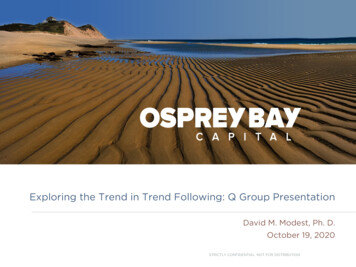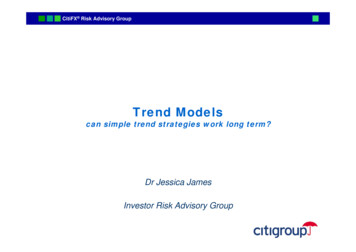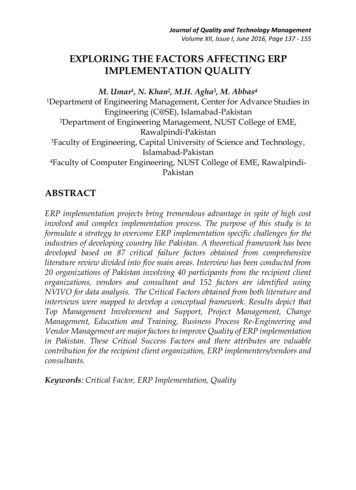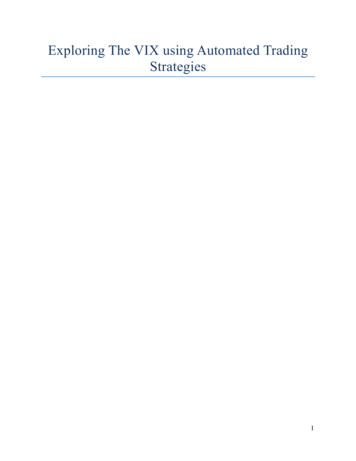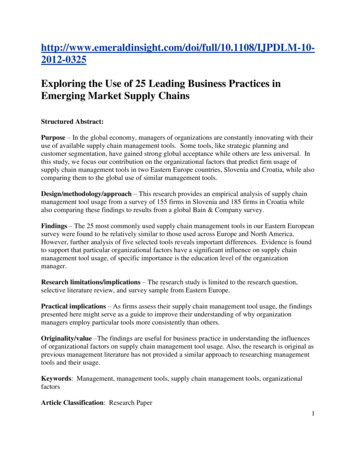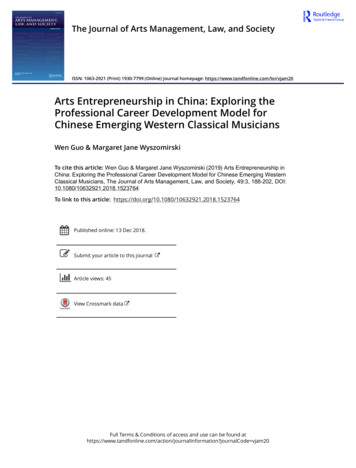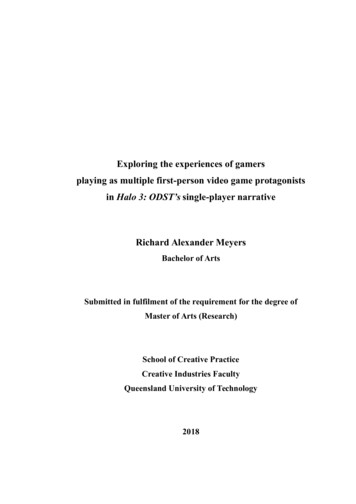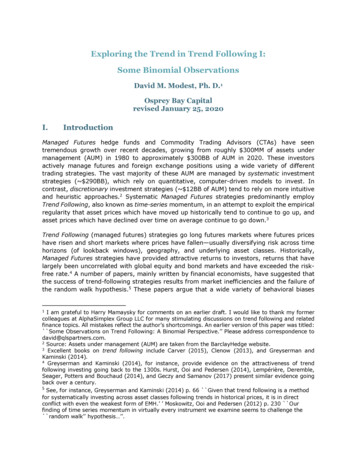
Transcription
Exploring the Trend in Trend Following I:Some Binomial ObservationsDavid M. Modest, Ph. D.1Osprey Bay Capitalrevised January 25, 2020I.IntroductionManaged Futures hedge funds and Commodity Trading Advisors (CTAs) have seentremendous growth over recent decades, growing from roughly 300MM of assets undermanagement (AUM) in 1980 to approximately 300BB of AUM in 2020. These investorsactively manage futures and foreign exchange positions using a wide variety of differenttrading strategies. The vast majority of these AUM are managed by systematic investmentstrategies ( 290BB), which rely on quantitative, computer-driven models to invest. Incontrast, discretionary investment strategies ( 12BB of AUM) tend to rely on more intuitiveand heuristic approaches.2 Systematic Managed Futures strategies predominantly employTrend Following, also known as time-series momentum, in an attempt to exploit the empiricalregularity that asset prices which have moved up historically tend to continue to go up, andasset prices which have declined over time on average continue to go down.3Trend Following (managed futures) strategies go long futures markets where futures priceshave risen and short markets where prices have fallen—usually diversifying risk across timehorizons (of lookback windows), geography, and underlying asset classes. Historically,Managed Futures strategies have provided attractive returns to investors, returns that havelargely been uncorrelated with global equity and bond markets and have exceeded the riskfree rate.4 A number of papers, mainly written by financial economists, have suggested thatthe success of trend-following strategies results from market inefficiencies and the failure ofthe random walk hypothesis.5 These papers argue that a wide variety of behavioral biasesI am grateful to Harry Mamaysky for comments on an earlier draft. I would like to thank my formercolleagues at AlphaSimplex Group LLC for many stimulating discussions on trend following and relatedfinance topics. All mistakes reflect the author’s shortcomings. An earlier version of this paper was titled: Some Observations on Trend Following: A Binomial Perspective.’’ Please address correspondence todavid@qlspartners.com.2Source: Assets under management (AUM) are taken from the BarclayHedge website.3Excellent books on trend following include Carver (2015), Clenow (2013), and Greyserman andKaminski (2014).4Greyserman and Kaminski (2014), for instance, provide evidence on the attractiveness of trendfollowing investing going back to the 1300s. Hurst, Ooi and Pedersen (2014), Lempérière, Deremble,Seager, Potters and Bouchaud (2014), and Geczy and Samanov (2017) present similar evidence goingback over a century.5See, for instance, Greyserman and Kaminski (2014) p. 66 Given that trend following is a methodfor systematically investing across asset classes following trends in historical prices, it is in directconflict with even the weakest form of EMH.’ ’ Moskowitz, Ooi and Pedersen (2012) p. 230 Ourfinding of time series momentum in virtually every instrument we examine seems to challenge the random walk’’ hypothesis ’’.1
and non-profit seeking behavior by market participants (such as by central banks or due torisk management controls) are the sources of market inefficiencies and price trends.6In this paper, I use a simple binomial framework to show (by counter example) that theexistence of positive profits from a trend-following strategy (on a single asset), on its own,provides no prima facie evidence on the efficiency or inefficiency of markets. In addition, Iexplore the most important feature of time series momentum investment strategies: thereturn shaping impact of trend following through its dynamic positioning. In a stylized efficientmarket setting (with no transaction costs), I show that the dynamic nature of trend followingshapes when profits and losses occur compared to a buy-and-hold strategy. There is,however, a conservation of “mass” in that gains and losses are shuffled across periods suchthat the unconditional distribution of profits is unaffected. In this sense, trend following, byconstruction, generates crisis alpha --- for crises where large losses occur over extendedperiods of time. I also show that fast and slow trend following strategies will shape returns indifferent ways. Due to its ability to shape when profit and losses occur, trend following canprovide significant portfolio diversification and hedging potential for those investors withstrategic risk-on exposures.In Section II, I consider the profitability of a simple trend-following strategy in a stationarybinomial framework that resembles coin tossing. The signal to go long or short is based onlast period’s “coin flip”. If the last “coin flip” is heads (tails), the strategy goes long (short).The strategy makes money if you are long and the next flip is heads, or if you are short andthe next flip is tails.7 Profits follow a random walk in that they do not in any way depend onthe past history of profits (or anything else), and the variance of profits is constant over time.The evolution of prices and profits are thus consistent with both weak- and strong-formmarket efficiency.8 I consider scenarios in which: a) heads and tails are equally likely (SectionII), and b) heads are more likely to occur than tails (Section V). In Section II, I demonstratethat: trend following will affect the timing of when profits occur and hence has the ability togenerate “crisis alpha”—even if prices have no trend (i.e., heads and tails are equally likely)and trend following has zero expected profit.9In section III, in a similar spirit, I show how buying a call option --- another dynamic strategy--- also changes the timing of when profits will occur. Section IV compares the performanceof faster-moving and slower-moving trend strategies. Section V considers a similar cointossing binomial framework where the probability of a head exceeds that of a tails. In thisenvironment, there is a structural expected profit to being long—and both long-only andtrend-following strategies, on average, generate positive profits. Hence, the existence ofpositive profits from a trend-following strategy, on its own, provides no prima facie evidence6See, for instance, Moskowitz, Ooi and Pedersen (2012) p. 229 and Greyserman and Kaminski (2014)Chapter 4.7Since the current position only depends on last period’s “coin flip”, I refer to this as fast trendfollowing in subsequent sections.8This framework thus abstracts from our real world experience, where asset prices have had timevarying and stochastic trends, volatilities, and correlations.9Martin and Zhou (2012) make a related point and show that even if returns are independently andidentically distributed, trend-following strategies can generate positive skewness. In a similar vein,Potters and Bouchaud (2008) demonstrate that trend-following strategies can affect the probability ofwinning trades but that this does not provide any information on the efficacy of the strategy. 2
on the efficiency or inefficiency of markets.10 Section VI concludes. One important conclusionis that regardless of the efficiency of asset markets, trend-following strategies are one wayto customize and alter the conditional return distribution of portfolios from that which couldbe earned by long-only investment strategies. In a forthcoming companion piece (Modest[2020]), I use a toy trend following model to explore how much of trend following profits arisefrom structural / passive (in the sense of Lo [2008]) exposures and how much arise fromtactical / dynamic positioning. Trend following strategies are often touted for their ability togo short as well as long. The companion piece also explores whether this perceived benefit isborne out by the data.II.Trend Following in a World without TrendConsider a futures investment environment that resembles “coin-tossing” with a fair coin.11There is a fifty percent probability of a head and fifty percent probability of a tail. Upon flippinga head, the investor who is long the futures contract earns a 10 profit, and upon flipping atail the long investor loses 10.12 Assume there are four “coin tosses” (i.e., four periods), andthe riskless rate of interest is zero. The potential cumulative dollar profits to a long futuresinvestor, at each date, are summarized in Figure 1.Figure 1: Cumulative Hypothetical Profits toLong-Only Investor 40 30 20 20 10 10 0 0 0- 10- 10- 20- 20- 30- 40Date 0Date 1Date 2Date 3Date 4While the existence of positive profits from trend-following strategies provides no evidence on theefficiency of markets, the magnitude of the profits will be related to the efficiency of markets and themartingale assumptions usually associated with financial markets.11Often referred to as a binomial framework.12Conceptually, one can think of the notional investment being altered each period to keep the dollarrisk fixed. Short positions earn the above profits with a negative sign.10 3
At the end of the first period (date 1), the long futures investor has either made or lost 10,each with a 50% probability. At the end of two periods (date 2), there are three possibleoutcomes for the long investor: 20 (25% probability), 0 (50% probability), and 20(25% probability). Similarly, at the end of four periods (date 4), there are five possibleoutcomes: 40, 20, 0, 20, and 40 profit. There are multiple paths that can be takento reach most outcomes in the binomial tree depicted in Figure 1.13 We can think of the stateof the world at date 4 where profits are 40 as a crisis, in that the long futures investorsuffers the worst outcome (a 40 drawdown).14 The expected cumulative profit over thefour periods is zero, the (four-period) variance of profits is 400,15 profits follow a randomwalk, and the market is efficient in that all information about future payoffs is known withcertainty. Figure 2 displays the payoff distribution of cumulative profits. As can be seen in thisfigure, the “boom” and “bust” outcomes occur 6.25% of the time, and the most likely outcomeis 0 profit (37.5%).Figure 2: Profit Probability .00%5.00%0.00%-40-2002040Let us now consider a (fast) trend-following strategy where the trend follower starts long themarket. If heads is tossed, the trend follower stays long, but if tails is tossed the trend followergoes short. This is a fast trend following strategy in that next period’s position only dependson the outcome of this period’s coin toss. As depicted in Table 1 below, there are sixteenpossible outcomes of this four-period investment. The outcomes have been colored codedThe exception are the “boom’’ outcome, which is only reached by tossing four heads in a row and the“crisis” outcome, which is only reached by tossing four tails’ in a row.14This framework precludes sharp short-term drawdowns such as occurred on Black Monday (October19, 1987) and the Flash Crash (May 6, 2010). Large drawdowns must result from a series of negativedraws over an extended period of time.15The one-period variance of profits is 100 and the corresponding standard deviation is 10. The fourperiod variance of profits is 400 and the corresponding standard deviation is 20. Variances increaselinearly with time whereas standard deviations only increase with the square root of time.13 4
where green indicates a profitable investment for the fast trend follower and red representsunprofitable investments. The maximum profit for both the long-only and fast-trend investorsis 40 and the maximum loss is - 40. The maximum loss for the long-only investor occurswhen four tails are thrown in a row (path #16) and the maximum loss for the trend investoroccurs when the path has maximum mean reversion (relative to the starting point; path #10).The expected profit from both strategies are zero and the variance of profits is 400.16 Theunconditional distributions of profits are identical for the two strategies: 6.25%Table 1: Hypothetical Outcomes and PayoffsDarte 3Date 412345678910111213141516Date 2PathDate 1Trend uddudduduuudduduudddudCumulative ProfitsFastLong 0-40402000020-200-20-40020-20-20020of the time the strategies deliver 40 of profit, 25% of the time the strategies earns 20profit, 37.5% of the time 0 profit, 25% of the time 20 profit, and 6.25% the strategiesboth earn 40.17 However, the dynamic nature of the trend-following strategy changes whenthe profits and losses occur. It generates 20 of profit during the market crisis (i.e., the stateswhere the cumulative profit from the long-only strategy is 40). Hence, in this crisis state,the trend-following strategy generates 60 of crisis alpha! This leads to observation #1.18Acar (1993) shows more generally that when prices follow a Gaussian random walk, the expectedprofit to any binary trading rule is zero and the variance of profits will equal the variance of theunderlying return distribution—independent of the trading rule.17In this four-period binomial example, there are sixteen different possible profit paths.18In this example, the long-only and trend-following strategies have identical unconditional distributionsof profit and loss. However, the conditional distributions (conditional on the realization of the underlyingasset) differ substantially.16 5
Observation #1:In this simplified binomial setting with no trend in asset prices, the trend-followingstrategy has the same expected profits and variance of profits as a long-onlyinvestment strategy. However, the dynamic nature of the trend-following strategyshapes the return distribution and substantially changes WHEN the profits andlosses occur.Figure 3 shows the average profit and (crisis) alpha19 of the (fast) trend-following strategy,conditional on the dollar profit of the long-only strategy.Figure 3: Aver
Trend Following, also known as time-series momentum, in an attempt to exploit the empirical regularity that asset prices which have moved up historically tend to continue to go up, and asset prices which have declined over time on average continue to go down.3 Trend Following (managed futures) strategies go long futures markets where futures prices have risen and short markets where prices .
